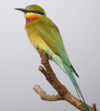INTRODUCTION
This was our first ever visit to Portugal as we had always associated it with packed, sun-tanned beaches, boozy night clubs and high-rise hotels - whereas Penny & me are more into quiet country lanes & high rise hills...........but Blimey! what great birding it offers.
TRAVEL & ACCOMMODATION
We travelled from Birmingham's excellent airport on bmibaby, just over £200 each way, all-in, including pre-booked seats. Ten minutes early on arrival, 15 minutes early back home (that's if you discount the two days 'ash cloud' delay - bmi most helpful on re-booking, with no charges.) Because we were staying out in the boondocks we hired a car from Economy Car Rentals, a Matiz for £ 210 inc all insurance for 14 days; OK car and efficient service. Booking accomodation independently is always a bit of a punt, but this time we caught really lucky, not only with the s/c apartment which was on the first floor of a new private house, set on a beautifully picturesque hillside, but with the owners who were very helpful & gave us lots of local information that added much to our holiday. They are (were?) not birders and were gobsmacked by the 25 species sighted from our appartment's 30' long balcony!
RESEARCH & TRIP ESSENTIALS
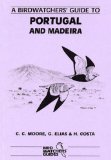 I had done a little research on birding in the Algarve and had realised that in my eagerness to bag a 'big list' it would be easy to spread myself too thinly. So we concentrated on Castro Marim, which was 15 minutes away (well, 35 if you include birding stops), Ria Formosa and the beach-cum-hillside area below the pretty village of Calca Velha - which became "our patch." We paid a short-ish visit to Quinta do Largo and spent another day at Castro Verde 'Bustard hunting!' I used various downloads as guides as well as Prion Birdwatchers' Guide to Portugal and Madeira
I had done a little research on birding in the Algarve and had realised that in my eagerness to bag a 'big list' it would be easy to spread myself too thinly. So we concentrated on Castro Marim, which was 15 minutes away (well, 35 if you include birding stops), Ria Formosa and the beach-cum-hillside area below the pretty village of Calca Velha - which became "our patch." We paid a short-ish visit to Quinta do Largo and spent another day at Castro Verde 'Bustard hunting!' I used various downloads as guides as well as Prion Birdwatchers' Guide to Portugal and Madeira by C.C.Moore et al which in truth I didn't find too helpful - seems very out of date despite having a reprint date of 2008.
by C.C.Moore et al which in truth I didn't find too helpful - seems very out of date despite having a reprint date of 2008.
We guessed that this would probably be our only visit to the Algarve so we also did a few trips out into the countryside 'being tourists' and as well as discovering some lovely towns, we also spotted some great birds out there; worthwhile sometimes to get away from the regular birding haunts and just keep your eyes peeled. Must mention Alcoutim and the road from it that follows the Guadiana river down-stream through wonderful scenery & lovely villages; it crosses a couple of tributaries over high bridges, always staying close to the river with good opportunities to park, admire the countryside and get some birding in, then arrives at the village of Azenhal, famous for it's annual Goat Festival - which we attended, fantasic; and it's cakes - which we sampled, equally fantastic!
In my area reports below I will only mention birds that were particularly noteable in each area, the majority of the other species were found almost everywhere we went.
SITES VISITED
Castro Marim
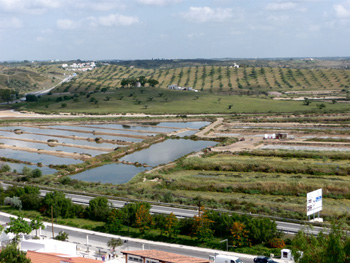 A simply fabulous place to go birding, it seemed that everytime we went, there was something different to see. Spread out over a very wide area around the village of Castro Marim (castle worth a visit) and bound on one side by the beautiful Guadiana River, the reserve is made up of a series of salt pans in various stages of use, some drained, some half full and others no longer in use. Open fields dotted with small patches of woodland, fresh-water pools fringed with low trees and bushes and of course the Guadiana itself with it's tributary the Carrasqueira, all offering superb birding. At first we used the above book but soon just worked the area out for ourselves; there is a reserve centre but we didn't get round to going - probably worth a visit. It's on the north-east side of the reserve at Cerro da Rocha, close to the new road bridge into Spain. Access via the N122 opposite the village of Monte Francisco, it is signposted and is a new building, easily seen, has parking - and Spoonbills in its pond! I made six visits to Marim at various times of day and was rewarded with 62 seperate species, many of these were also seen at other sites so I'll not list them all but........Greater Flamingo; Purple Heron; Spoonbill; Spotted Redshank; Lesser Short-toed Larks; Short-toed Larks; Calandra Lark; Southern Grey Shrike; Great Spotted Cuckoo; Booted Eagle; Zitting Cisticola; Golden Plover & lots of Bee-eaters should give a flavour of the area. Parking is at a premium at one or two places but on a couple of occasions I parked in the village & walked, no doubt the reserve centre would have more info and maps etc.
A simply fabulous place to go birding, it seemed that everytime we went, there was something different to see. Spread out over a very wide area around the village of Castro Marim (castle worth a visit) and bound on one side by the beautiful Guadiana River, the reserve is made up of a series of salt pans in various stages of use, some drained, some half full and others no longer in use. Open fields dotted with small patches of woodland, fresh-water pools fringed with low trees and bushes and of course the Guadiana itself with it's tributary the Carrasqueira, all offering superb birding. At first we used the above book but soon just worked the area out for ourselves; there is a reserve centre but we didn't get round to going - probably worth a visit. It's on the north-east side of the reserve at Cerro da Rocha, close to the new road bridge into Spain. Access via the N122 opposite the village of Monte Francisco, it is signposted and is a new building, easily seen, has parking - and Spoonbills in its pond! I made six visits to Marim at various times of day and was rewarded with 62 seperate species, many of these were also seen at other sites so I'll not list them all but........Greater Flamingo; Purple Heron; Spoonbill; Spotted Redshank; Lesser Short-toed Larks; Short-toed Larks; Calandra Lark; Southern Grey Shrike; Great Spotted Cuckoo; Booted Eagle; Zitting Cisticola; Golden Plover & lots of Bee-eaters should give a flavour of the area. Parking is at a premium at one or two places but on a couple of occasions I parked in the village & walked, no doubt the reserve centre would have more info and maps etc.
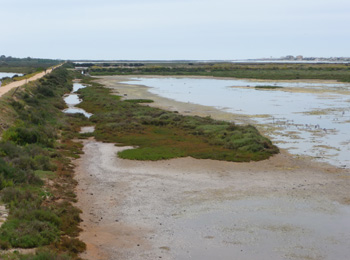 Quinto do Largo
Quinto do Largo
Strewth, this is a hard place to find. One of the problems is that currently the town of Almansil has extensive road works and the diversion takes you away from the road to the reserve. That road doesn't peter-out any more (no pun intended!) as the guides indicate and the reserve sign, tucked-away on a bend, is easily missed. Anyway we eventually found it but had limited time to spend there. 38 species seen including Purple Swamphen; Thekla Lark; Calandra Lark; Red-crested Pochard; Yellow Wagtail (iberiae); Black-necked Grebe; Ruff and Bar-tailed Godwit. More time spent, especially on the eastern-side "Discovery Walk" would have undoubtedly brought more.
Castro Verde
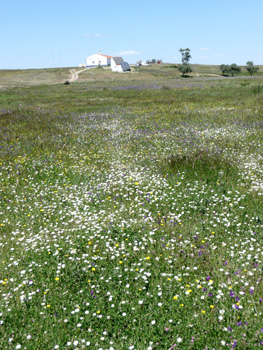 Our trip to 'Liga para a Proteccao da Natureza' at Castro Verdi was a highlight of the holiday for lots of reasons - but let's do the birds first. The journey via Mertola and through picturesque countryside gave us Black Kite; Red Kite and Black-winged Kite for starters. I suppose most people associate Castro Verde with the Great Bustard and it is a fine job that the people there are doing. We had superb views of a flock of about 30, then got two flying across the reserve; they are big fellows! In addition we got Short-toed Eagle; Montagu's Harrier; Lesser Kestrel (breeding in some numbers here); Roller; Griffon Vulture; Little Bustard and Merlin. 39 species in all. Castro Verde is described as "pseudo-steppe", being an area of sweepingly glorious meadow-land, un-ending rolling fields of grasses and wild flowers as far as the eye can see. "Pseudo" because it has been created out of a barren landscape which was left over from a failed attempt to create a vast area of wheat fields, intended as the 'bread basket' of Portugal. There are many walks designated in this area & details can be obtained from the LPN at Castro Verde. All would be great for birding. It's probably best to stay for a couple of nights in this area to get full value from this very large reserve.
Our trip to 'Liga para a Proteccao da Natureza' at Castro Verdi was a highlight of the holiday for lots of reasons - but let's do the birds first. The journey via Mertola and through picturesque countryside gave us Black Kite; Red Kite and Black-winged Kite for starters. I suppose most people associate Castro Verde with the Great Bustard and it is a fine job that the people there are doing. We had superb views of a flock of about 30, then got two flying across the reserve; they are big fellows! In addition we got Short-toed Eagle; Montagu's Harrier; Lesser Kestrel (breeding in some numbers here); Roller; Griffon Vulture; Little Bustard and Merlin. 39 species in all. Castro Verde is described as "pseudo-steppe", being an area of sweepingly glorious meadow-land, un-ending rolling fields of grasses and wild flowers as far as the eye can see. "Pseudo" because it has been created out of a barren landscape which was left over from a failed attempt to create a vast area of wheat fields, intended as the 'bread basket' of Portugal. There are many walks designated in this area & details can be obtained from the LPN at Castro Verde. All would be great for birding. It's probably best to stay for a couple of nights in this area to get full value from this very large reserve.
In reading trip reports and birding blogs whilst preparing for this trip I read some fairly severe criticisms of the work being done by the Portugese volunteers on their reserves and by the LPN in particular. Sad. My fellow British birders, we don't know we are born! 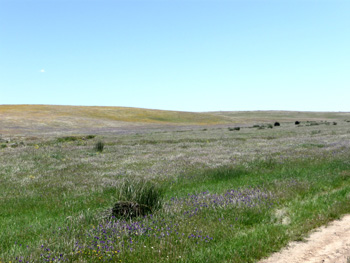 We have the RSPB; English Nature; Scottish Conservency Council; the BTO; National Trust; dozens of County-based Wildlife Trusts and heaven knows who else, all working together to provide and protect our habitats. The guys & gals working on the Portugese reserves are faced with constant hunting, political apathy, bemusement in their community, untold pressure from the tourist industry (that's us folks!) obstruction from farmers and opposition from Big Business. The very helpful and informative girl at Castro Verde told us that they had received a small grant from the European Community Environmental Fund and also a small grant from Norway (?) and were grateful for that! Let's make sure that when we visit these reserves we offer them all the support we can, they really are pleased to welcome birders from other countries, it's confirmation to them that their work is recognised elsewhere.......and let's stop whingeing about having to pay a couple of quid to visit a LNR in the UK!
We have the RSPB; English Nature; Scottish Conservency Council; the BTO; National Trust; dozens of County-based Wildlife Trusts and heaven knows who else, all working together to provide and protect our habitats. The guys & gals working on the Portugese reserves are faced with constant hunting, political apathy, bemusement in their community, untold pressure from the tourist industry (that's us folks!) obstruction from farmers and opposition from Big Business. The very helpful and informative girl at Castro Verde told us that they had received a small grant from the European Community Environmental Fund and also a small grant from Norway (?) and were grateful for that! Let's make sure that when we visit these reserves we offer them all the support we can, they really are pleased to welcome birders from other countries, it's confirmation to them that their work is recognised elsewhere.......and let's stop whingeing about having to pay a couple of quid to visit a LNR in the UK!
Ria Formosa
We had planned that our accomodation, as well as being close to Castro Marim, would enable us to have ready access to various parts of the Ria Formosa reserve and we quickly established "our patch" as being a stretch of beach into which ran a small stream and was fringed with trees, bushes and grassy scrubland. The stretch of sea formed part of the Ria Formosa lagoon. This delightful area was close-by the scenic village of Calca Velha and we paid frequent and rewarding visits. We saw 37 species here including most of the "usual suspects" such as Bee-eater; Little Egret; Azure-winged Magpie; Hoopoe; 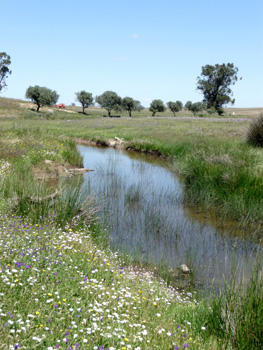 Crested Lark; White Stork; Goldfinch; Little Tern; Cetti's Warbler; Grey Plover and Turtle Dove. Of particular note on our patch were Whimbrel; Serin; Nightingale; Melodious Warbler; Golden Oriole & our favourites, Kentish Plover. The Ria Formosa reserve has its HQ and Educational Centre on the eastern side of the town of Olhao: access is from a roundabout on the N125 just as you leave Olhao in the direction for Tavira, the brown reserve sign is clearly visible as you approach the island, turn right then 250 metres through a small village brings you to the gates. There is a small entrance fee, currently 2 euros 50; well worth it. An interesting mixture of woodland, heathland, freshwater pools, saltwater marsh and saltwater pools that are flooded by the tide twice daily, this place gave us some great birding with probably more habitat variety than in any other reserve we visited. (If anyone in the UK is intending to visit Ria Formosa this year I have a couple of leaflets I would be happy to copy & forward to you - see end of report.) Birds of particular interest included Cuckoo; Great Spotted Cuckoo; scores of Knot in breeding plumage; two-dozen Ringed Plover; Yellow Wagtail; Sparrowhawk; Iberian Chiffchaff; Cetti's Warbler; Dunlin and a score of Terrapin basking around a freshwater pool - I know, not birds, but very interesting nonetheless. Like everywhere we visited the reserve is covered in many varieties of wild flowers, a botanist's dream, we did notice though that by the end of the fortnight many of the flowers were 'going over' so if one is interested, mid-May would be the latest time to visit.
Crested Lark; White Stork; Goldfinch; Little Tern; Cetti's Warbler; Grey Plover and Turtle Dove. Of particular note on our patch were Whimbrel; Serin; Nightingale; Melodious Warbler; Golden Oriole & our favourites, Kentish Plover. The Ria Formosa reserve has its HQ and Educational Centre on the eastern side of the town of Olhao: access is from a roundabout on the N125 just as you leave Olhao in the direction for Tavira, the brown reserve sign is clearly visible as you approach the island, turn right then 250 metres through a small village brings you to the gates. There is a small entrance fee, currently 2 euros 50; well worth it. An interesting mixture of woodland, heathland, freshwater pools, saltwater marsh and saltwater pools that are flooded by the tide twice daily, this place gave us some great birding with probably more habitat variety than in any other reserve we visited. (If anyone in the UK is intending to visit Ria Formosa this year I have a couple of leaflets I would be happy to copy & forward to you - see end of report.) Birds of particular interest included Cuckoo; Great Spotted Cuckoo; scores of Knot in breeding plumage; two-dozen Ringed Plover; Yellow Wagtail; Sparrowhawk; Iberian Chiffchaff; Cetti's Warbler; Dunlin and a score of Terrapin basking around a freshwater pool - I know, not birds, but very interesting nonetheless. Like everywhere we visited the reserve is covered in many varieties of wild flowers, a botanist's dream, we did notice though that by the end of the fortnight many of the flowers were 'going over' so if one is interested, mid-May would be the latest time to visit.
On the eastern outskirts of Tavira, signposted from a roundabout next to the large "Gran Plaza" shopping complex, are a series of salt pans divided by a narrow-ish road. Worth a look, park at the far end by the sea (watch your tyres, its a bit rough) and walk back, scanning the pans. This was the first area we birded and immediately got a good indication of what we could anticipate with Black-winged Stilt; Skylark; Grey Plover; Avocet; Little Stint; Curlew Sandpiper; Little Tern and Sardinian Warbler.
The Balcony
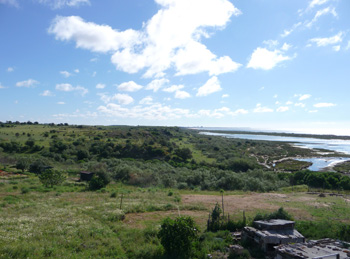 Earlier I mentioned that we had seen 20-odd species from the balcony on our appartment and I feel this is worth noting, as it gives an indication of just how rich the bird-life is here, even away from the reserves. The hillsides around the appartment were scattered with Rock Rose, Sagres Gorse, Olive trees, Bramble and Tamarisk and like everywhere else the ground was covered in wild flowers. All very typical of the countryside in this part of Portugal, so I feel that the list is quite representative of the kind of birding one could expect when taking walks in this area. So, sitting comfortably, feet up, 'sundowner' at the ready we saw Woodchat Shrike; Calandra Lark; Crested Lark; Azure-winged Magpie; House Sparrow; Golden Oriole; Spotless Starling; Starling; Barn Swallow; Red-rumped Swallow; Swift; Pallid Swift; Alpine Swift; House Martin; Short-toed Eagle; Stonechat; Red-legged Partridge; Corn Bunting; Skylark; Bee-eater; Goldfinch; Blackbird; Collared Dove; Wood Pigeon; Hoopoe; Chaffinch and Sardinian Warbler. In addition we heard a Sparrowhawk and a Chiffchaff. I make that 26, not bad - our best 'balcony spot' yet.
Earlier I mentioned that we had seen 20-odd species from the balcony on our appartment and I feel this is worth noting, as it gives an indication of just how rich the bird-life is here, even away from the reserves. The hillsides around the appartment were scattered with Rock Rose, Sagres Gorse, Olive trees, Bramble and Tamarisk and like everywhere else the ground was covered in wild flowers. All very typical of the countryside in this part of Portugal, so I feel that the list is quite representative of the kind of birding one could expect when taking walks in this area. So, sitting comfortably, feet up, 'sundowner' at the ready we saw Woodchat Shrike; Calandra Lark; Crested Lark; Azure-winged Magpie; House Sparrow; Golden Oriole; Spotless Starling; Starling; Barn Swallow; Red-rumped Swallow; Swift; Pallid Swift; Alpine Swift; House Martin; Short-toed Eagle; Stonechat; Red-legged Partridge; Corn Bunting; Skylark; Bee-eater; Goldfinch; Blackbird; Collared Dove; Wood Pigeon; Hoopoe; Chaffinch and Sardinian Warbler. In addition we heard a Sparrowhawk and a Chiffchaff. I make that 26, not bad - our best 'balcony spot' yet.
SUMMARY
"Reasons to be cheerful"........Swifts........Goat Festivals.......Alentajo Flower Meadows........the LPN volunteers..........Calca Velha........sundowners and Woodchat Shrikes......Guadiana River.....and Kentish Plovers.
Our kind & helpful hosts are re-thinking their letting policy and therefore have asked me not to include their details in this report; should they let me know their future plans I will add them at a later date.
THE BIRDS
Mallard......................................................Anas platyrhynchos
Gadwall.....................................................Anas strepera
Shoveler...................................................Anas clypeata
Pochard....................................................Aythya ferina
Red-crested Pochard...........................Netta rufina
Tufted Duck............................................Aythya fuligula
Red-legged Partridge..........................Alectoris rufa
Black-necked Grebe.............................Podiceps nigricollis
Little Grebe...........................................Tachybaptus ruficollis
Great Crested Grebe..........................Podiceps cristatus
Cormorant................................................Phalacrocorax carbo
Cattle Egret...........................................Bubulcus ibis
Little Egret.............................................Egretta garzetta
Grey Heron..............................................Ardea cinerea
Purple Heron...........................................Ardea purpurea
White Stork...........................................Ciconia ciconia
Spoonbill...................................................Platelea leucorodia
Greater Flamingo..................................Phoenicopterus ruber
Griffon Vulture.....................................Gyps fulvus
Short-toed Eagle.................................Circaetus gallicus
Booted Eagle..........................................Aquila pennata
Red Kite..................................................Milvus milvus
Black Kite...............................................Milvus migrans
Marsh Harrier......................................Circus aeruginosus
Montagu's Harrier..............................Circus pygargus
Common Buzzard..................................Buteo buteo
Sparrowhawk........................................Accipiter nisus
Black-winged Kite...............................Elanus caeruleus
Kestrel....................................................Falco tinninculus
Lesser Kestrel.....................................Falco naumanni
Merlin......................................................Falco columbarius
Moorhen..................................................Gallinula chloropus
Coot.........................................................Fulcia atra
Purple Swamphen.................................Porphyria porphyria
Great Bustard.....................................Otis tarda
Little Bustard......................................Tetrax tetrax
Avocet....................................................Recurvirostra avosetta
Black-winged Stilt..............................Himantopus himantopus
Little Ringed Plover............................Charadrius dubitus
Ringed Plover........................................Charadrius hiaticula
Kentish Plover......................................Chariadrius alexandrinus
Grey Plover...........................................Pluvialis squatarola
Golden Plover........................................Pluvialis apricaria
Knot.........................................................Calidris canutus
Sanderling..............................................Calidris alba
Turnstone..............................................Arenaria interpres
Dunlin.......................................................Calidris alpina
Curlew Sandpiper.................................Calidris ferruginea
Little Stint............................................Calidris minuta
Common Sandpiper...............................Actitis hypoleucos
Spotted Redshank...............................Tringa erythropus
Black-tailed Godwit.............................Limosa limosa
Bar-tailed Godwit................................Limosa lapponica
Whimbrel................................................Numenius phaeopus
Ruff...........................................................Philomachus pugnax
Black-headed Gull.................................Larus ridibundus
Mediterranean Gull...............................Larus melanocephalus
Yellow-legged Gull.................................Larus michahellis
Lesser Black-backed Gull...................Larus fuscus graellsi
Common Tern..........................................Sterna hirundo
Little Tern..............................................Sterna albifrons
Rock Dove................................................Columba livia
Wood Pigeon............................................Columba palumbus
Collared Dove..........................................Streptopelia decaocta
Turtle Dove.............................................Streptopelia turtur
Cuckoo........................................................Cuculus canorus
Great Spotted Cuckoo.........................Clamator glandarius
Little Owl.................................................Athene noctua
Common Swift..........................................Apus apus
Pallid Swift...............................................Apus pallidus
Alpine Swift.............................................Apus melba
Hoopoe.......................................................Upupu epops
Bee-eater................................................Merops apiaster
Roller..........................................................Coracias garrulus
Skylark......................................................Alauda arvensis
Crested Lark...........................................Galerida cristata
Thekla Lark.............................................Galerida theklae
Short-toed Lark....................................Calendrella brachydactyla
Lesser Short-toed Lark.....................Calendrella rufescens
Calandra Lark.........................................Melanocorypha calandra
Barn Swallow...........................................Hirundo rustica
Red-rumped Swallow............................Hirundo daurica rufula
House Martin..........................................Delichon urbica
Meadow Pipit..........................................Anthus pratensis
White Wagtail.......................................Motacilla alba
Yellow Wagtail.......................................Motacilla flava iberiae
Grey Wagtail.........................................Motacilla cinerea
Nightingale..............................................Luscinia megarhynchos
Northern Wheatear............................Oenanthe oenanthe
Stonechat...............................................Saxicola torquatus
Mistle Thrush.......................................Turdus viscivorus
Blackbird................................................Turdus merula
Sardinian Warbler..............................Sylvia melanocephala
Zitting Cisticola...................................Cisticola juncidis
Cetti's Warbler..................................Cettia cetti
Melodious Warbler.............................Hippolais polyglotta
Willow Warbler....................................Phylloscopus trochilus
Iberian Chiffchaff.............................Phylloscopus ibericus
Great Tit...............................................Parus major
Blue Tit..................................................Cyanistes caeruleus
Iberian Grey Shrike..........................Lanius meridionalis
Woodchat Shrike................................Lanius senator
Azure-winged Magpie.......................Cyanopica cyanus
Magpie...................................................Pica pica
Jay.........................................................Garrulus glandarius
Jackdaw................................................Corvus monedula
Carrion Crow........................................Corvus corone
Raven......................................................Corvus corax
Starling.................................................Sturnus vulgaris
Spotless Starling...............................Sturnus unicolor
Golden Oriole.......................................Oriolus oriolus
House Sparrow....................................Passer domesticus
Spanish Sparrow.................................Passer hispaniolensis
Tree Sparrow......................................Passer montanus
Chaffinch..............................................Fringilla coelebs
Linnet.....................................................Carduelis cannabina
Goldfinch...............................................Carduelis carduelis
Greenfinch............................................Chloris chloris
Serin......................................................Serinus serinus
Corn Bunting.........................................Milaria calandra
118 in total including 10 'lifers'.
Tony Jones
